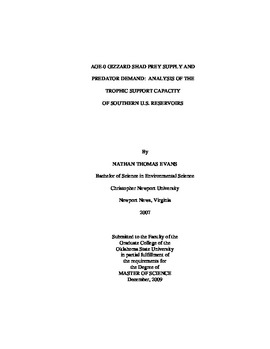| dc.contributor.advisor | Shoup, Daniel E. | |
| dc.contributor.author | Evans, Nathan Thomas | |
| dc.date.accessioned | 2014-04-15T21:59:41Z | |
| dc.date.available | 2014-04-15T21:59:41Z | |
| dc.date.issued | 2009-12-01 | |
| dc.identifier.uri | https://hdl.handle.net/11244/9167 | |
| dc.description.abstract | Gizzard shad Dorosoma cepedianum, the primary prey in many lakes and reservoirs of the southern U.S., often comprise a majority of the prey biomass in the systems in which they are found. However, they rapidly grow to a size that surpasses the preferred prey sizes of most piscivores. Lakes and reservoirs may, therefore, be prey limited if age-0 gizzard shad abundances are low. Previous studies have not considered the effect of the prey supply of age-0 gizzard shad on the entire piscivore community in a reservoir or the effect of age-0 gizzard shad availability on the growth and condition of piscivores in reservoirs. This study used bioenergetics modeling and Monte Carlo simulations to quantify the abundance of age-0 gizzard shad necessary to sustain seven sport fish species, common to the southern U.S., at diverse growth rates, population sizes, mortality rates, and proportions of gizzard shad in piscivore diets. Annual gizzard shad consumption estimates for individual piscivore species ranged from < 0.01 to 482.5 (kg/ha/year). Annual necessary gizzard shad abundance (accounting for non-predation mortality and reproductive surplus required for prey sustainability) estimates ranged from < 10/ha/piscivore population to > 128,000/ha/piscivore population. Monte Carlo simulations indicated that gizzard shad abundance at the 50th percentile of published age-0 gizzard shad abundances was insufficient to support piscivore communities > 69% of the time. Current findings support the hypothesis that systems must have high prey resource availability to support diverse sport fish communities with high-condition and abundance. | |
| dc.format | application/pdf | |
| dc.language | en_US | |
| dc.publisher | Oklahoma State University | |
| dc.rights | Copyright is held by the author who has granted the Oklahoma State University Library the non-exclusive right to share this material in its institutional repository. Contact Digital Library Services at lib-dls@okstate.edu or 405-744-9161 for the permission policy on the use, reproduction or distribution of this material. | |
| dc.title | Age-0 Gizzard Shad Prey Supply and Predator Demand: Analysis of the Trophic Support Capacity of Southern U.S. Reservoirs | |
| dc.type | text | |
| dc.contributor.committeeMember | Echelle, Anthony A. | |
| dc.contributor.committeeMember | Dzialowski, Andrew R. | |
| dc.contributor.committeeMember | Long, James M. | |
| osu.filename | Evans_okstate_0664M_10637.pdf | |
| osu.college | Agricultural Sciences and Natural Resources | |
| osu.accesstype | Open Access | |
| dc.description.department | Department of Natural Resource Ecology and Management | |
| dc.type.genre | Thesis | |
